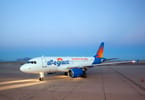More destinations versus higher fares. It’s the balancing act that often comes when two airlines join forces.
Yet it’s just one concern about how the combination of United and Continental likely will affect air travelers.
Shareholders and federal regulators haven’t yet approved United’s $3 billion dollar acquisition of Continental, but industry observers are already anticipating the possibilities.
Here’s a look at five ways the creation of a new United Airlines may affect fliers:
1. Fares
They’re not likely to skyrocket, but don’t be surprised if average fares rise 5 to 7 percent, said George Hobica, creator of the Airfarewatchdog.com.
Routes where the two airlines have overlapping nonstop flights — Houston to Denver and Newark to San Francisco, for example — are most likely to increase. That’s because less competition often means higher fares.
Business travelers are the most likely to see hikes because their fares aren’t driven down as much by the competition from low-fare airlines.
Families planning summer getaways will be relieved. Fare increases will be softened for the leisure traveler because their ticket prices are driven largely by low-fare providers, like JetBlue Airways and Virgin America, said David Stempler, president of the Air Travelers Association, a passenger advocacy group.
Continental CEO Jeff Smisek and United CEO Glenn Tilton said Monday their goal is to draw more business fliers at top dollar. They expect their expanded flight offerings to pull in as much as $900 million a year in additional revenue from corporate travelers.
2. Fees
Don’t expect them to change much. They’ll remain in effect and they’ll stay high. Airline fee revenue rose 42 percent to $7.8 billion last year thanks to the charges for checked bags, carrying pets or making reservation changes, according to the Department of Transportation. United took in $619.5 million in fees last year and Continental added $539.7 million.
3. Frequent flier miles
Continental’s frequent flier miles have no expiration date but United’s expire in 18 months. It wasn’t immediately clear which policy the new United would adopt.
Travelers with miles accumulated on both airlines will gain the advantage of combining them, which could mean they will have enough to earn free flights.
However, merged airlines usually reduce jet fleets, leaving fewer open seats.
“All the great opportunities to earn miles may mean not enough seats to accommodate a doubling of the frequent flyer family,” said Michael Cintron, a spokesman for Dallas-based International Airline Passengers Association.
4. Destinations
Don’t expect many cities to disappear from the new United’s destination roster. The combined airline will need to fly to many of the cities United and Continental serve now to support the long-range domestic and international flights it wants to provide. Industry observers point to Continental’s strong presence on the East Coast and in the New York area, while United’s focus is on the West Coast and in the Midwest with it’s Chicago hub.
Reductions could come in overlapping hubs like Cleveland and Washington Dulles.
Some changes may be required by antitrust regulators in the U.S. Department of Justice, who are examining the deal. The new United might be required to divest certain routes, gates or a percentage of available seats to keep it from controlling too much of the market at some locations.
5. Seamless flying
Perhaps the biggest benefit from the merger will be the ability to fly to more locations without switching airlines.
Flights to China, Europe and Latin America, for example, may become easier as passengers are allowed to stay on a United jet.
Cintron agreed the benefits of seamless flying and more destination choices are advantages fliers get from airlines joining together. “But at what cost?” he asks.
Travelers will need to look the new company’s routes and those offered by competitors’ alliances, then compare costs and the convenience of flying on one airline the entire trip.
United and Continental have set up a Web site. It includes links to routes and communities served.
Details will become clearer in the coming months giving travelers plenty of time to weigh the impact. Changes won’t go into effect until late this year or early 2011 after the deal closes.
WHAT TO TAKE AWAY FROM THIS ARTICLE:
- Industry observers point to Continental’s strong presence on the East Coast and in the New York area, while United’s focus is on the West Coast and in the Midwest with it’s Chicago hub.
- The combined airline will need to fly to many of the cities United and Continental serve now to support the long-range domestic and international flights it wants to provide.
- The new United might be required to divest certain routes, gates or a percentage of available seats to keep it from controlling too much of the market at some locations.






![China's Hyperloop Train: A Glimpse into the Future of Transportation 4 Travel Tourism News | Domestic & International Hyperloop Train China [Photo: Hyperloop Transportation Technologies]](/cdn-cgi/image/width=145,height=100,fit=crop,quality=80,format=auto,onerror=redirect,metadata=none/wp-content/uploads/2024/02/180720163348-hyperlooptt-china-capsule.jpg)















